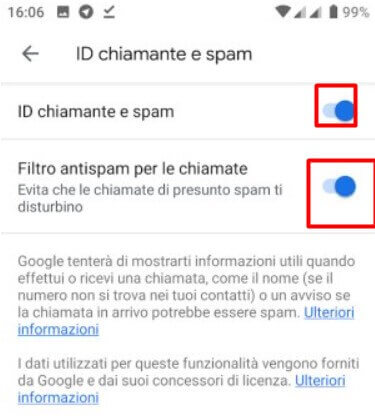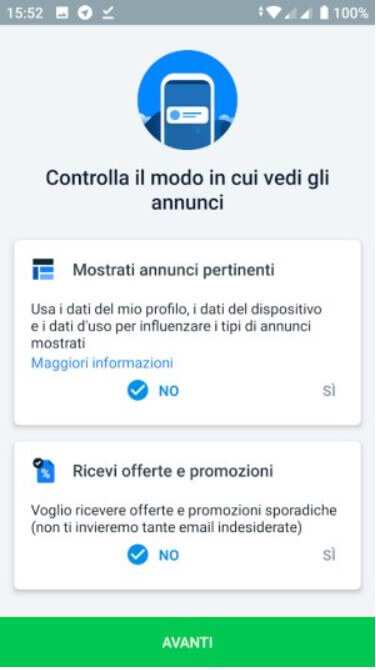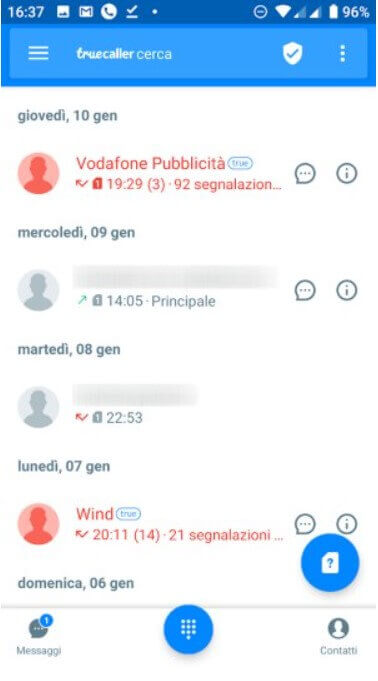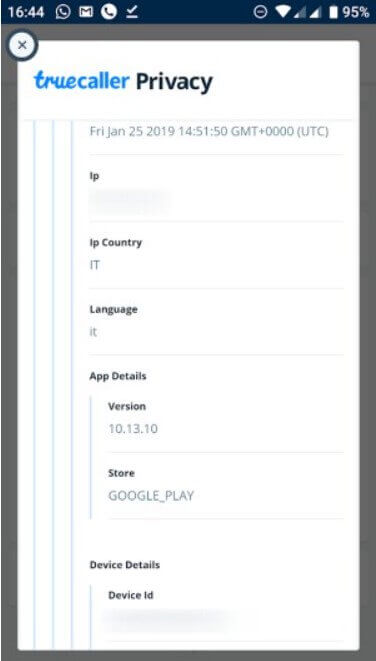TrueCaller is one of the most popular apps for recognizing unwanted calls and contact names, not in the address book. Pros and cons.
TrueCaller is certainly not a new app: it has been available for years, is compatible with Android and iOS devices, and has been the subject of several of our articles.
According to the Finnish company that developed the application, by now, over 250 million users are using it all over the world: the operation is very simple and meets a rather common need among users, that is to find out who an unknown number belongs to, even before answering the call.
From the very first rings of the phone TrueCaller detects the incoming call and searches for the fixed or mobile number in its database. In the event that the number is present, TrueCaller will show the name of the caller in clear text, inside a box that will overlap the one we are used to.
The TrueCaller telephone number database is truly vast: the app is particularly useful for detecting calls from call centers or spam contacts that usually offer useless commercial offers.
By acting on the TrueCaller settings, it is even possible to ask that the smartphone not even ring in case of calls from numbers belonging to call centers and spammers or unknown (the Whooming app is always the best to “discover” who calls with a private or obscured number).
Owners of an Android 8 Oreo or Android 9 Pie smartphone, in general, do not even need applications like TrueCaller because the Google operating system integrates a mechanism, closely linked with the phone dialer, to automatically block unwanted calls.
It is enough to access the app settings Phone “stock” of Android, touch the three dots in the column (upper right), then click caller ID and spam: as you can see, the default is that Android automatically blocks the unwanted calls.

TrueCaller plays an extra role because it tries to provide contacts, not in the address book who are calling from landlines and mobile numbers in the Finnish company’s database.
The privacy aspect: how TrueCaller composes and enriches its database
Many online magazines explain that TrueCaller continuously updates and enriches its database by directly drawing on the users’ contact book’s contents.
This, however, is not true: TrueCaller clearly states this in its privacy policy: ” We do not store or share any personal information of contacts from your address book “.
The same developer policies of Google and Apple expressly prohibit the appropriation and uploading of user contact books with transfer to remote servers. If anything, the processing can only be done locally, and this is the operation carried out by TrueCaller.
However, the app collects information on the user who decides to install it, on the image attached to his profile, on his phone number, on the terminal he is using, and more. These data are used to enrich the TrueCaller database together with those provided by the user himself.
For example, when the TrueCaller box appears, after having closed an unwanted call, the user can highlight it as such and specify the caller’s name: this information will be collected, transmitted on the TrueCaller servers, and subsequently used to improve the behavior of the application.
Still, in the privacy policy, the developers of TrueCaller point out that the user who installs the app can be used for advertising purposes and possibly shared with third parties.
Compared to some time ago, TrueCaller has become an app that requires many permissions to work: here, the company rattles them off one by one, explaining why they are requested and used.
Also, a few days ago, TrueCaller has turned into an application that aspires to do a few too many things: wants to be an app to exchange messages between users who use it, wants to extrapolate the most relevant information from SMS (for example, valid “one-off” or OPT codes for accessing services that allow two-factor authentication ), aims to classify incoming messages based on their type (separating the important ones from the spam ones), offers a function for backing up SMS, call history, blocklists (with upload for example on Google Drive ).
Honestly a bit too much for an app that should be limited to helping users fight phone spam.
If you decide to install TrueCaller, it is good to be aware of the required permissions and possibly avoid sharing some data (see the image below).

Furthermore, TrueCaller does not necessarily have to be configured as the default app for handling calls and SMS. It responds negatively to requests like the one in the figure ( Cancel ) TrueCaller will still work and will show its box for each incoming call.

And it is not even mandatory – God forbid – to activate the backup of the history of calls, contacts, messages, the list of blocked numbers on Google Drive. Just answer Later and carry on.

At this point, the main screen of TrueCaller will read all the latest calls, and for those coming from numbers, not in the phonebook, the name of the caller detected by the app database will often be read.

The TrueCaller search box allows you to search for phone numbers or the details of other users (the latter, however, will not be visible, they require the activation of a Premium subscription, and the authorization to view the data is always on request, which can be approved or denied by a third party).
The user data that TrueCaller has stored on its servers can be accessed from the main menu by clicking on Settings, then on Privacy Center, and finally on Access my data. Here it can be verified that TrueCaller stores the user’s public IP, app version, device ID, operating system, smartphone name and model, serial numbers of inserted SIM cards, names of telecommunications providers, name and surname of the user, unique profile identifier, telephone number with international code, email address, statistics on activities managed with the app.

Always from the Privacy Center section, it is possible to abandon TrueCaller at any time by requesting the cancellation of your data at the same time.
Suppose your name appears in the database searchable from the web by referring to this page. In that case, you can request its removal by filling out this form (your number will be removed within 24 hours, as also explained in the article Search for a mobile number and go back to the name of the holder ).
Finally, TrueCaller has entered into agreements with specialized companies to access public lists of commercial activities and business contacts.

A tech-savvy writer with a knack for finding the latest technology in the market, this is what describes John Carter. With more than 8 years of experience as a journalist, John graduated as an engineer and ventured soon into the world of online journalism. His interest includes gadget reviews, decoding OS errors, hunting information on the latest technology, and so on.













